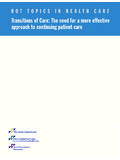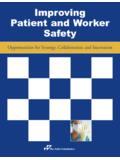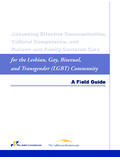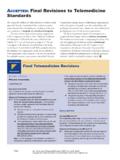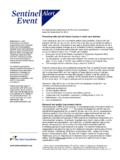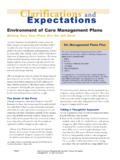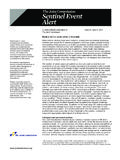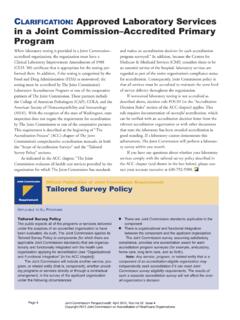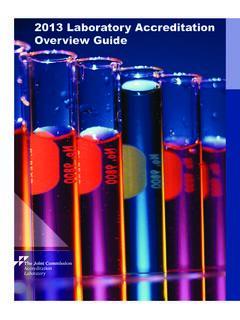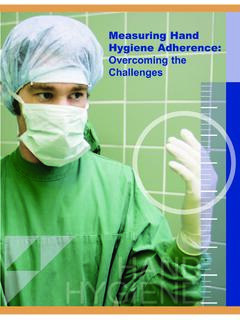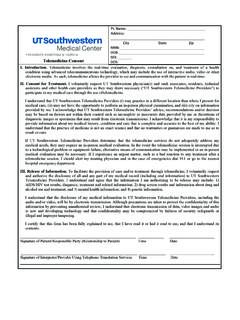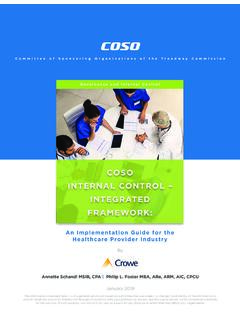Transcription of National Patient Safety Goal for ... - Joint Commission
1 2019 The Joint Commission A complimentary publication of The Joint Commission Issue 18, Nov. 27, 2018 UPDATED Nov. 20, 2019 National Patient Safety Goal for suicide prevention Effective July 1, 2019, seven new and revised elements of performance (EPs) were applicable to all Joint Commission -accredited hospitals and behavioral health care organizations. Effective July 1, 2020, these requirements also will be applicable to Joint Commission -accredited critical access hospitals. These new requirements are at National Patient Safety Goal (NPSG) and are designed to improve the quality and Safety of care for those who are being treated for behavioral health conditions and those who are identified as high risk for suicide .
2 Because there has been no improvement in suicide rates in the , and since suicide is the 10th leading cause of death in the country, The Joint Commission re-evaluated the NPSG in light of current practices relative to suicide prevention . Engagement with stakeholders, customers, and experts In addition to an extensive literature review and public field review, The Joint Commission held five technical expert panel meetings between June 2017 and March 2018. The results of the first four meetings were published in the November 2017, January 2018, and February 2018 editions of The Joint Commission Perspectives. The revisions for the critical access hospital (CAH) accreditation program only have been posted on the Prepublication Standards page of The Joint Commission website and will be available online until the end of June 2020.
3 The new and revised EPs also will be published online in the spring 2020 E-dition update of the CAH accreditation program, and in print in the 2020 Update 1 to the Comprehensive Accreditation Manual for the CAH accreditation program. After July 1, 2020, please access the new requirement in the E-dition or standards manual. National Patient Safety Goal : Reduce the risk for suicide . HAP Note: EPs 2-7 apply to patients in psychiatric hospitals and patients being evaluated or treated for behavioral health conditions as their primary reason for care . In addition, EPs 3-7 apply to all patients who express suicidal ideation during the course of care . CAH Note: EPs 2-7 apply to patients in psychiatric distinct part units in critical access hospitals or patients being evaluated or treated for behavioral health conditions as their primary reason for care in critical access hospitals.
4 In addition, EPs 3-7 apply to all patients who express suicidal ideation during the course of care . Published for Joint Commission -accredited organizations and interested health care professionals, R3 Report provides the rationale and references that The Joint Commission employs in the development of new requirements. While the standards manuals also may provide a rationale, R3 Report goes into more depth, providing a rationale statement for each element of performance (EP). The references provide the evidence that supports the requirement. R3 Report may be reproduced if credited to The Joint Commission . Sign up for email delivery. Issue 18, Nov. 27, 2018 Page 2 UPDATED Nov.
5 20, 2019 National Patient Safety Goal for suicide prevention 2019 The Joint Commission Requirement NPSG , EP 1: BHC: The organization conducts an environmental risk assessment that identifies features in the physical environment that could be used to attempt suicide ; the organization takes necessary action to minimize the risk(s) (for example, removal of anchor points, door hinges, and hooks that can be used for hanging). Note: Noninpatient behavioral health care settings and unlocked inpatient units do not need to be ligature resistant. The expectation for these settings is to conduct a risk assessment to identify potential environmental hazards to individuals served, identify individuals who are at high risk for suicide , and take action to safeguard these individuals from the environmental risks (for example, continuous monitoring in a safe location while awaiting transfer to higher level of care and removing objects from the ro om that can be used for self-harm).
6 HAP: For psychiatric hospitals and psychiatric units in general hospitals: The hospital conducts an environmental risk assessment that identifies features in the physical environment that could be used to attempt suicide ; the hospital takes necessary action to minimize the risk(s) (for example, removal of anchor points, door hinges, and hooks that can be used for hanging). For nonpsychiatric units in general hospitals: The organization implements procedures to mitigate the risk of suicide for patients at high risk for suicide , such as one-to -one monitoring, removing objects that pose a risk for self-harm if they can be removed without adversely affecting the Patient s medical care , assessing objects brought into a room by visitors, and using safe transportation procedures when moving patients to other parts of the hospital.
7 Note: Nonpsychiatric units in general hospitals are not expected to be ligature-resistant environments. Nevertheless, these facilities should assess clinical areas to identify objects that could be used for self-harm and should be routinely removed when possible from the area around a Patient who has been identified as high risk for suicide . This information can be used for training staff who monitor high risk patients (for example, developing checklists to help staff remember which equipment should be removed when possible). CAH: For psychiatric distinct part units in critical access hospitals: The critical access hospital conducts an environmental risk assessment that identifies features in the physical environment that could be used to attempt suicide ; the critical access hospital takes necessary action to minimize the risk(s) (for example, removal of anchor points, door hinges, and hooks that can be used for hanging).
8 For nonpsychiatric units in critical access hospitals: The organization implements procedures to mitigate the risk of suicide for patients at high risk for suicide , such as one-to -one monitoring, removing objects that pose a risk for self-harm if they can be removed without adversely affecting the Patient s medical care , assessing objects brought into a room by visitors, and using safe transportation procedures when moving patients to other parts of the critical access hospital. Note: Nonpsychiatric units in critical access hospitals are not expected to be ligature-resistant environments. Nevertheless, these facilities should assess clinical areas to identify objects that could be used for self-harm and should be routinely removed when possible from the area around a Patient who has been identified as high risk for suicide .
9 This information can be used for training staff who monitor high risk patients (for example, developing checklists to help staff remember which equipment should be removed when possible). Issue 18, Nov. 27, 2018 Page 3 UPDATED Nov. 20, 2019 National Patient Safety Goal for suicide prevention 2019 The Joint Commission Rationale The health care environment, including Patient rooms, Patient bathrooms, corridors, and common Patient care areas can contain features that patients can use to attempt suicide . The most common hazards for suicide risk are ligature anchor points that can be used for hanging. However, there are many other types of hazards, so it is important to do a thorough assessment of the environment to minimize all potential suicide risks.
10 For nonpsychiatric units that are not required to be ligature-resistant, the focus should be on rigorous implementation of protocols to keep patients safe, especially one-to -one monitoring. For more information, see The Joint Commission Perspectives article, November 2017, Volume 37, Number 11. The Veteran s health Administration showed that use of a Mental health Environment of care Checklist to facilitate a thorough, systematic environmental assessment reduced the rate of suicide from per 100,000 admissions to per 100,000 admissions. There was no loss of effect over seven years of implementing this policy and processes. Reference* Watts BV, et al. Sustained Effectiveness of the Mental health Environment of care Checklist to Decrease Inpatient suicide .
